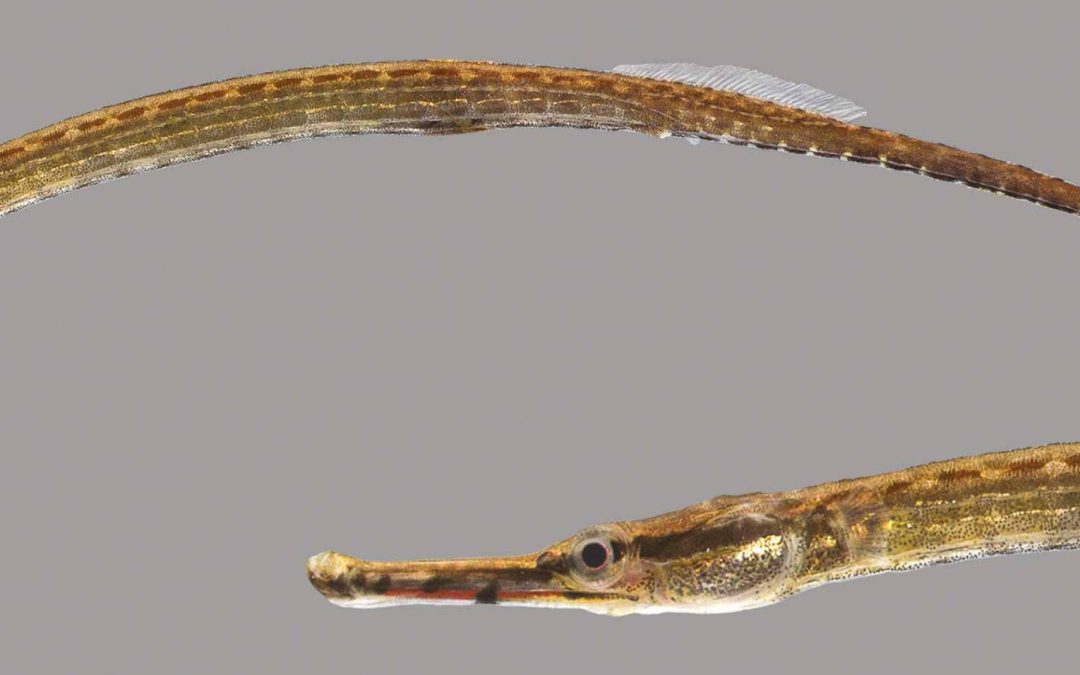
by Rick O'Connor | Feb 18, 2022
I recently posted an article about the seahorses of the Florida panhandle. It would be remiss of me if I did not include their close cousins the pipefish. Where seahorses are well known but hard to find, pipefish are easy to find but not well known.
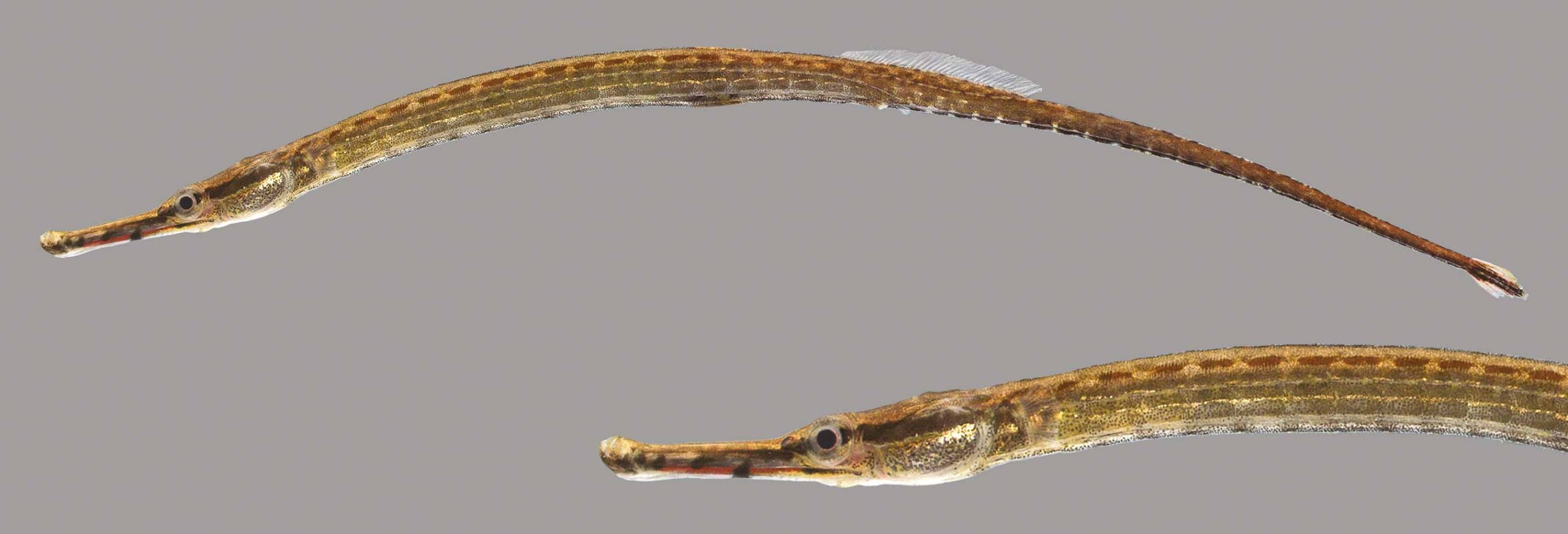
The seahorse-like pipefish.
Photo: University of Florida
Pipefish are in the same family as seahorses, Syngnathidae, and are basically elongated seahorses. Pulling seine nets in local grassbeds we often catch them. Students always ask what they are. “Are these needlefish?” is a frequent question. I reply “no, they are pipefish”. Which then comes “pikefish?”. To which I reply “No, PIPEfish… like P-I-P-E… – they are basically elongated seahorses”. And then there is always – “coool”. To which I reply “yes… very cool”.
Pipefish have the same body armor, body rings, and long tube snout of the seahorse. However, they lack the curled prehensile tail for a more elongated body, looking more a grass blade than their cousins. They actually have a caudal fin (the fin most call “fish tail”). Most range between 3-6 inches long but the chain pipefish can reach a length of 10 inches, this is the “big boy” of the group. Like seahorses, they hide in the grass using their tube-shaped mouths to suck in small planktonic food. Like the seahorses, the males’ possess a brood pouch to carry the fertilized eggs and give live birth (ovoviviparous).
The pipefish can quickly be divided into two groups – those with long snouts, and those with short – and this can be easily seen when captured in a net. After that identification gets a bit tricky, you have to count rays in the fins or rings on the body. It is sufficed to say, “it’s a pipefish” and leave it at that.
Those with long snouts include the Opossum, Chain, Dusky, and Sargassum pipefish.
The Opossum Pipefish (Microphis brachyurus) is about 3 inches long and was not reported from the northwestern Gulf of Mexico according to Hoese and Moore1. In the eastern Gulf, our way, it is considered rare but has been found in salt marshes, seagrasses, and in Sargassum mats drifting in from the Gulf. The Florida Museum of Natural History list this fish as a “marine invader”2. In 1991 NOAA listed it as a species of concern due to its decline across the region3. There are reports of this pipefish entering freshwater creeks within our estuaries.
The Chain Pipefish (Syngnathus louisianae) has a very long snout and is the “big boy” of the group reaching 10 inches in length. It is quite common along the panhandle and has one of the larger ranges of this group, found all along the Atlantic coast, throughout the Gulf of Mexico and in the Caribbean.
The Dusky Pipefish (Syngnathus floridae) is a long-snout, large pipefish reaching a length of eight inches. It prefers higher salinity than many pipefish and is found throughout the Gulf of Mexico and along the Atlantic seaboard often offshore.
The Sargassum Pipefish (Syngnathus pelagicus). This is a good scientific name for this fish (pelagicus) for it lives on the large mats of Sargassum weed that drifts across the oceans. Because of this it has a worldwide distribution. This longnose pipefish reaches the typical length of six inches. It lives as many other pipefish do hiding in the grass snapping up food when it comes close enough but it’s habitat is often drifting offshore and inshore sightings of this species are rare.
There are three species of “short-snout” pipefish.
The Fringed Pipefish (Anarchopterus crinigerus) is a smaller pipefish reaching only three inches. It seems to be absent in the western Gulf but is found along the Florida panhandle, the Gulf coast of peninsula Florida, and through the Caribbean to Brazil.
The Northern Pipefish (Syngnathus fuscus) reaches a length of six inches. It is very common along the Atlantic seaboard but Hoese and Moore1 report only four specimens from the Gulf of Mexico. This one would be considered very rare, and an expert should identify it if one thinks they have it.
The Gulf Pipefish (Syngnathus scovelli) is one of the more common pipefish collected in our waters. It is a short-snout species reaching the typical six inches but has these distinct bluish-gray bars that run vertically along the sides. It is found throughout the Gulf of Mexico and even into some freshwater habitats. The Florida Museum of Natural History also list this species as a marine invader4.
I am not sure how much seining you do along our waterways, but if you do any within the grassbeds you are sure to find one of these unique and interesting fish.
References
1 Hoese, H.D., Moore, R.H. 1977. Fishes of the Gulf of Mexico. Texas A&M Press, College Station TX. Pp. 327.
2 Opossum pipefish. Discover Fishes. Florida Museum of Natural History. https://www.floridamuseum.ufl.edu/discover-fish/florida-fishes-gallery/opossum-pipefish/.
3 Opossum Pipefish. Species of Concern. National Oceanic and Atmospheric Administration, National Marine Fisheries Service. https://www.nrc.gov/docs/ML1224/ML12240A312.pdf.
4 Gulf Pipefish. Discover Fishes. Florida Museum of Natural History. https://www.floridamuseum.ufl.edu/discover-fish/florida-fishes-gallery/gulf-pipefish/.
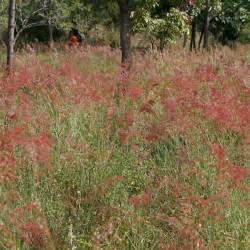
by Rick O'Connor | Feb 11, 2022
EDRR Invasive Species
Natal grass (Melinis repens)

Natalgrass
Photo: University of Florida IFAS
Define Invasive Species: must have ALL of the following –
- Is non-native to the area, in our case northwest Florida
- Introduced by humans, whether intentional or accidental
- Causing either an environmental or economic problem, possibly both
Define EDRR Species: Early Detection Rapid Response. These are species that are either –
- Not currently in the area, in our case the Six Rivers CISMA, but a potential threat
- In the area but in small numbers and could be eradicated
Native Range:
South Africa
Introduction:
Intentionally introduced as a forage plant but lacks the nutritional value of other introduced forage plants.
EDDMapS currently list 3,923 records of this plant, all are across the southern United States from California to Florida. 3,591 reports are from Florida itself, with 53 of these in the Florida panhandle, and 31 of those within Six Rivers CISMA.
Description:
This reddish colored grass can cover large areas of open fields. The reddish color comes from the hair-like structures that are associated with the flowers and will become gray with age. The flowers themselves are a pink-purple in color and are produced from panicles (a cluster of small flowers) that are 4-8 inches long. The grass can reach a height of 40 inches and dispersal is by wind blown seeds.
Issues and Impacts:
It aggressively grows in open fields and displaces native grass species from these areas. Many of which are important to local ecology.
Management:
Hand removal of small patches can be effective, but the property owner should be aware of the ease of seed dispersal when doing this, it is recommended to remove prior to going to seed. It tends to quickly invade open areas of disturbance including the use of fire. Mowing does not provide control.
The herbicides glyphosate and imazapyr have shown to have good control but must be used prior to going to seed. Both herbicides are non-selective, and care must be taken not to treat native plants. Imazapyr has a longer soil life and replanting the area after treatment may not be effective for several months.
There are no known biological controls at this time.
If you are in the Florida panhandle area and believe you may have natal grass, please contact your county extension office to let them know as well as report the siting to www.EDDMapS.org. If you have questions on how to do this, your county extension office can help.
For more information on this EDRR species, contact your local extension office.
References
University of Florida IFAS Center for Aquatic and Invasive Plants. Natal Grass. https://plants.ifas.ufl.edu/plant-directory/melinis-repens/.
Early Detection and Distribution Mapping System (EDDMapS)
https://www.eddmaps.org/
Six Rivers CISMA
https://www.floridainvasives.org/sixrivers/
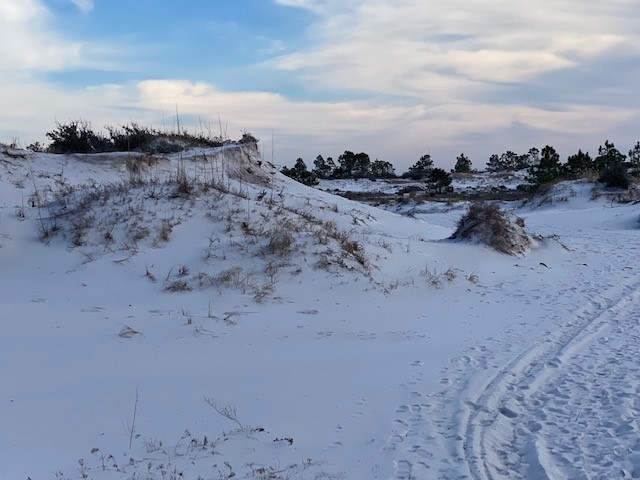
by Rick O'Connor | Feb 10, 2022
It is now mid-winter and much colder than our trip in January. During February’s hike the temperature was 44°F, compared to 62°F in January. It was overcast with a cold breeze from the northeast – again, colder. When conditions are like this I am not expecting to see much. If I did find something I would expect it to be one of our warm blood friends, mammals or birds, and even they would prefer a day with more sun and less breeze. But I came to see what was out roaming. So, a hike I made.
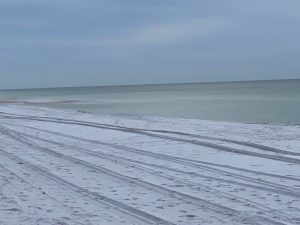
The Gulf front at Park East near Big Sabine.
This month I hiked the Big Sabine area east of Pensacola Beach. It began with a shore walk along the Gulf and then a transect across the different dune fields to the marshes and seagrasses along the Santa Rosa Sound.
There was no one out today. You could see footprints in the sand, and it had that characteristic “squeak” sound of fresh sand or snow. The only wildlife I saw on the Gulf side was a group of pelicans sitting on very calm water, obviously enjoying the morning. However, you could see footprints of mammals that had come earlier. There are raccoons, armadillos, mice, coyotes, and occasional reports of otters on Santa Rosa Island. There were a lot of skunks on the island prior to Hurricane Ivan (2004), but I have not seen any since. There have been reports of bears on the island as well. I have never seen one, nor their tracks, so do not think they are frequent visitors. I did find a dead shark tossed up on the beach by a fisherman. Not sure if they were trying to catch it or not.
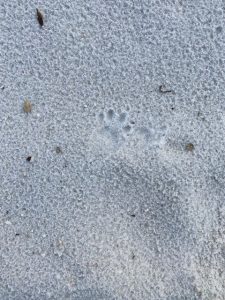
A variety of mammals are found on barrier islands. Most move at night and you know they are there only by their tracks.
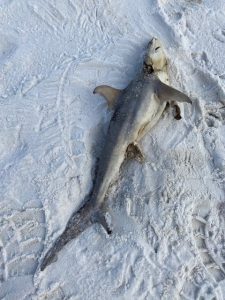
This small shark was found on the beach during the hike. I am not sure why they did not return it to the Gulf.
As I began my transect across the island I ventured into the secondary dune field, which during summer is extremely hot. This part of the island reminds me somewhat of a desert. Very dry, open, and at times very hot. Like the desert it comes alive more at night, but during winter you might see animal movement during the warm parts of the day. I did see mammalian tracks, which included humans and dogs.
This dune field also holds ephemeral ponds which can harbor a variety of life during the warmer months. Today I only found one blooming yellow-bladder wort as well as other carnivorous plants along the bank such as sundews and ground pines.
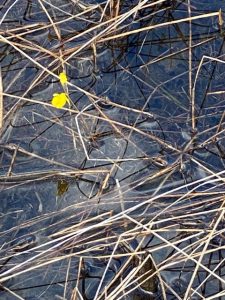
Yellow bladder wort is one of the small carnivorous plants that live on our barrier islands.
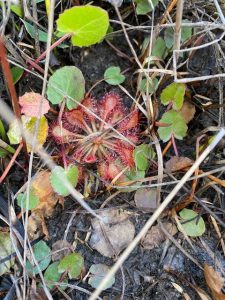
Sundews are another one of the small carnivorous plants found here.
From the open dune field, you venture into the tertiary dunes and the maritime forest. Trees grow here but their growth is stunted due to the salt content in the air. None the less, pine and oak hammocks liter this dune area providing great hiding places for wildlife. Though we did not see any today, I am expecting to find some as the weather warms.
The backside of the island is where you will find the salt marsh. This brackish wetland harbors its own community of creatures, which were not visible today but will be in the spring. Between the tertiary dunes and the marsh runs a section of the Florida Trail. Hikers can walk this section and observe wildlife from both ecosystems.
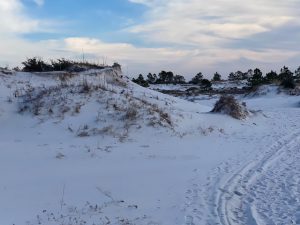
The larger dunes of the tertiary dune field.
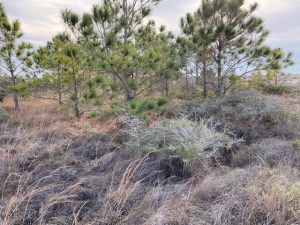
Tree hammocks are common in the tertiary dune fields and provide good places for wildlife.
I eventually reached the Sound and the seagrass beds that exist there. Today, here was nothing really moving around, though I did find a dead jellyfish drifting in the waves. As the island wildlife tends to hideout the winter in burrows, the fish move to deeper water where it is warmer.
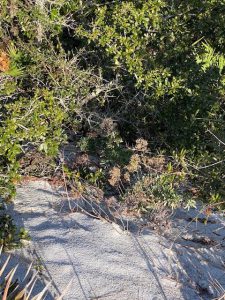
The backside of these large dunes drop quickly back to sea level.
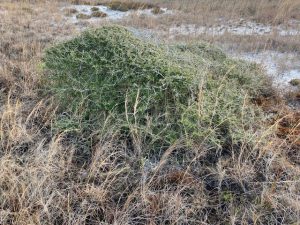
Many plants in the tertiary dunes exhibit “wind sculpting”. It appears someone has taken a brush and “brushed” the tree towards the Sound.
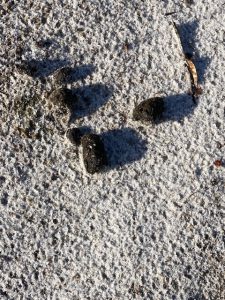
Scat is another sign used to identify mammal activity in the dunes.
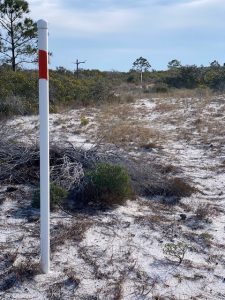
Portions of the Florida Trail cut through the tertiary dune field of Big Sabine.
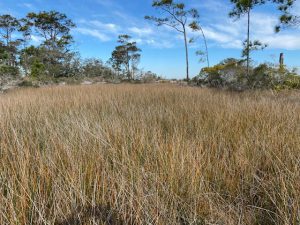
The salt marsh
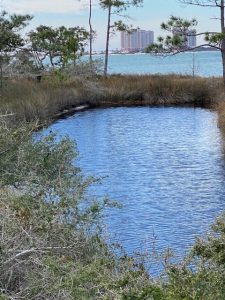
This holding pond is a remnant of an old fish hatchery from the late 1950s and is primarily freshwater.
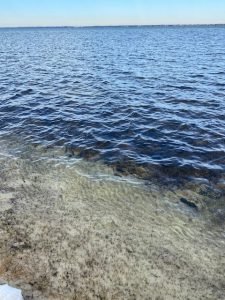
Seagrass meadows can be found in Santa Rosa Sound and harbor a variety of marine life.
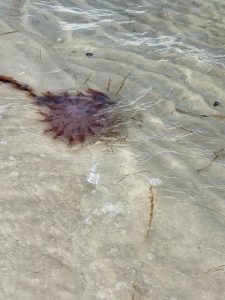
Jellyfish are common on both sides of the island. This one has washed ashore on Santa Rosa Sound.
There was little out today other than a few birds. We will see what late winter will expose next month.
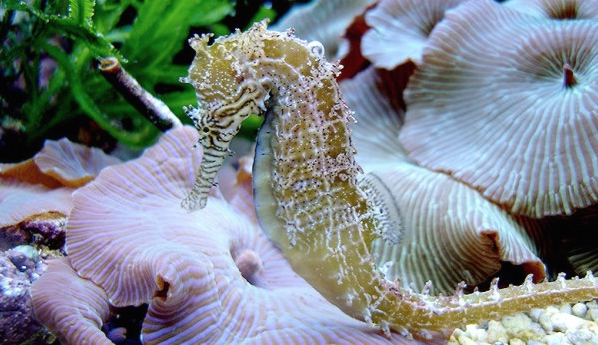
by Rick O'Connor | Feb 3, 2022
Seahorses are one of the coolest creatures on this planet – period. I mean who doesn’t like seahorses? People state “I love snakes”, “I hate snakes”, “I love sharks”, “I hate sharks”. But no one says, “I hate seahorses”. They are sort of in the same boat with sea turtles, everyone loves sea turtles. They are an icon of the sea, logos for beach products and coastal HOAs, underwater cartoons and tourist development boards, diving clubs and local restaurants. But have you ever seen one? I mean beyond seeing one at a local aquarium or such, have you ever found one while snorkeling on one of our beaches?
Most would say no.
I have lived in the panhandle all my life and have spent much of it in the water, and I can count on both hands the number of times I have encountered a seahorse while at the beach. Most encounters have been while seining. I cannot count on both hands how many times I have pulled a seine net here but very few of them did a seahorse encounter occur. When they did, it was over grassbeds. In each encounter the animal was lying in the grass not wriggling like the other fish, just lying there. It would be very easy to miss them discarding it as “grass”. It makes you wonder how many times I captured one and did not know it. When we did find one it was VERY exciting. My students would often scream “I had NO idea they lived here!”.

The seahorse Photo: NOAA
However, if you tried searching for them while snorkeling, which I have, the encounter rate is zero. But this makes sense. These animals are so well camouflaged in the grass it would be a miracle to find one just hanging there. This is by necessity really. If you have ever watched a seahorse in an aquarium they are not very “fleet of foot”. Escaping a predator by dashing away is not one of their finer skills. No, they must blend in and remain motionless if trouble, like a snorkeler, comes by.
But I have seen one while diving. It was a night dive near the Bob Sikes Bridge on Pensacola Beach about 40 years ago. We were exploring when my light swung over to see this large seahorse extended from a pipe that was coming out of some debris on the bottom. I was jubilated and screamed, as best you can while using SCUBA, for my partners to come check this out. We were all amazed and my interest in these animals increased.
When I attended Dauphin Island Sea Lab (DISL) as an undergraduate student, like many in the 1970s, I thought I would get involved with sharks, but I quickly developed a love for estuaries and my interest in seahorses returned. I made a visit to the library there and found very little in the literature, at that time, which piqued my interest even more. My senior year we had to complete a project where we had to collect, and correctly identify, 80 species of fish to pass the class. I asked the crew of the research vessel at DISL if they had ever found seahorses. They responded yes and took me to what they called their “seahorse spot”. We caught some. It was very cool. And yes… seahorses do exist here in the wild.
But what is this amazing animal?
What do I mean by this? As a marine science instructor, I would give my students what are called a lab practical’s. Assorted marine organisms would be scattered around the room and the students had to give their common name, phylum name, class name, and answer some natural history question I would ask. Snails are mollusk, mackerel are fish, jellyfish are cnidarians, and then they would come to the seahorse. Seahorses were… well… seahorses! What the heck are they?
Many of you may know they are fish. But over the years of teaching marine science, I found that many students were not sure of that. The definition of a fish is an animal with a backbone that possesses a scaly body, paired fins (usually), and gills. Seahorses have all that. There is a backbone no doubt. The scales are not as obvious because they are actually fused together in a sort of armor. The paired fins and gills are there. Yep… they are fish, but a fish (horse) of a different color.

This seahorse is a species from Indonesia.
Photo: California Sea Grant.
First, they are one of about 13 families of fish in the Gulf of Mexico that lack ventral fins, those on the belly side of their bodies. Second, they lack a caudal fin (the fish tail) and have a more prehensile tail for grabbing objects. Third, they swim vertically instead of horizontally as most fish do. Again, there is nothing about their body design that says “speed”.
Another thing I find fascinating about these animals is their global distribution. You might recall that the initial focus of this series on Florida panhandle vertebrates was the biogeography of these creatures. Seahorses are found all over the world. There are over 350 species of them. But the interesting question is: how would a seahorse living in the northern Gulf of Mexico reach Melbourne Australia? It makes sense that being so far apart there would be such differences in looks and genetics that they would be classified as different species, but how did an animal like a seahorse disperse across a large ocean like the Pacific?
Honestly, I can say the same for ghost crabs, which I found on the beaches of Hawaii. How did they get there? But that is another story.
My best guess was the dispersal occurred at a time when the two continents were closer together. The Pangea days, or some time close to that period. And as the continents “drifted” the seahorses remained close to their shorelines and moved apart. They may have been able to “island hop” across coral reefs to other Indonesian Islands, but those here in the United States were long lost relatives that changed in their appearance and lifestyles due to the large separation from others. That is my two cents anyway.
Hoese and Moore1 list two species of seahorses found here in the northern Gulf of Mexico. The Lined Seahorse and the Dwarf Seahorse.
The Lined Seahorse (Hippocampus erectus) is the larger of the two, reaching an average length of five inches. This is the one I found near the Bob Sikes Bridge all those years ago. Like all seahorses they are well adapted to life in debris where they can grab on to something with their prehensile tail and feed on small zooplankton using their vacuum like tube snout. Like all seahorses, the males have a brood pouch that holds the fertilized eggs producing live birth – another “live bearer”. They are usually dark in color, but gold individuals have been reported. Some have filamentous threads on their bodies making them look even more like plants. Their biogeographic distribution is amazing. They are found from Nova Scotia, throughout the tropics, all the way to Argentina. This suggests few biogeographic barriers, other than substrate to hide in.
The Dwarf Seahorse (Hippocampus zosterae) – also known as the pygmy seahorse – is much smaller, with a mean length of 1.5 inches. That would qualify as “dwarf” or “pygmy”. How would you ever find these? Other than size, the difference between these two are the number of rays (soft spines) in their fins. They can be counted, but its not fun, especially with a 1.5” seahorse. This guy prefers high salinity, actually, I have found that most seahorses do. This one is more tropical in distribution.
There is a third Florida species, the long snout seahorse (Hippocampus redi) that is found on the Atlantic coast, but not in the Gulf.
The strange thing about the seahorses in Florida, has been the declining encounters over the last few decades. For a creature that seems to have few barriers, they have found trouble somewhere. Maybe the loss of habitat, maybe a population crash due to the common practice years ago of capture and drying out for tourists to buy. It could be a change in environmental conditions such as salinity in the Pensacola Bay area. I am not sure. The more I write this article, the more my interest in this fish returns. As many researchers and wildlife managers have mentioned, this is an animal who has “fallen through the cracks”. People notice the changes in sea turtle and manatee encounters, but not seahorses. Maybe it is time we pay more attention to them and see how they are doing. I for one would hate to see the decline of this creature here in the panhandle.
Reference
Hoese, H.D., Moore, R.H. 1977. Fishes of the Gulf of Mexico; Texas, Louisiana, and Adjacent Waters. Texas A&M Press, College Station, TX. Pp. 327.

by Rick O'Connor | Feb 3, 2022
Based on our seine surveys along the beaches of most estuaries in the Florida panhandle, this is one of the most abundant fish in our bays. No matter the time of year, or the location, estuarine seining usually includes numerous individuals of this group. It is very apparent the importance they play in the food web of our local bays.

The silverside, or “glass” minnow.
Photo: U.S. Geological Survey
Those visiting and recreating in our waters probably are not aware of the numerous individuals of this fish schooling all around them. They are almost transparent and are often called “glass minnows” because of this. So, you do not really see them – even if you are snorkeling. But take a small hand net or a seine net and you will quickly discover they are there – and a lot of them.
They are small three-inch fish that are long, and tube shaped with forked (lunate) tails. Their bodies have a slight yellow-green appearance on the dorsal side, but much is a whiteish in color or transparent all together. They do have a broad silver stripe that runs laterally along their body and is where they get their common name “silversides”. Anchovies also have this “silverside” and are found in the same locations but differ from the silversides in that they have a more “shark looking snout” and only one dorsal fin, compared to the two dorsal fins found on the silversides.
It is apparent this whiteish, transparent color and silver stripe are effective in avoiding predation. Again, you and I do not see them while we are snorkeling. But is also apparent that many are consumed due to the large number you find in their schools. I have found from my seining surveys this fish is often collected on days when no other species are. The heat of summer, the cool of winter, during and after storms, high humidity, it does not matter – I always captured them. I have captured them over sandy beaches, over seagrasses, near jetties, and in the muck and mire of salt marshes. They are literally everywhere. I also capture them more frequently than I do anchovies, suggesting their importance to the health of the estuarine food web. It is one of the first fish my students learned to identify because of how frequently we caught them.
In the northern Gulf, there are two species found in local estuaries – the rough silverside and the tidewater silverside. Hoese and Moore1 do report a third species similar to the tidewater silverside that is more tolerant of saltwater.
The Rough Silverside (Membras martinica) is called so because their body scales are serrated and are “rough to the touch”. This is when you slide your fingers from the back towards the head, your fingers will feel the serrations and it is rough to the touch.
The Tidewater Silverside (Menidia beryllina) is smooth to the touch because their scales lack serrations. Other than that, these two fish look very similar. Tidewater silversides seem to be restricted to the shorelines and do not venture to the extended grassbeds off the beach. The third species mentioned M. peninsulae, is reported to prefer salinities at and above 19 ppt, where the tidewater prefers lower salinities. There is little else mentioned to distinguish these two, but I have seen both names reported in the scientific literature from researchers sampling our bay.
Both species of silversides have a large biogeographic distribution. Ranging from the colder waters of New York, all along the eastern seaboard, and the entire Gulf of Mexico.
You may not see them often, but know they are an important part of the estuarine ecology.
Reference
Hoese, H.D., Moore, R. H. 1977. Fishes of the Gulf of Mexico; Texas, Louisiana, and Adjacent Waters. Texas A&M Press, College Station TX. Pp. 327.






















